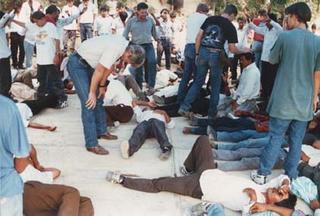ENGLISH:The Ascension of Jesus Christ is one of the Great Feasts of the Orthodox Church, celebrated forty days after Pascha (and thus always falling on a Thursday).
Forty days after the Resurrection, while blessing his disciples (Gospel of Luke 24:50-51), Christ ascended into heaven, taking his place at the right hand of the Father (Gospel of Mark 16:19 and Nicene-Constantinopolitan Creed).
The first account of the Ascension found in the Bible is in the Gospel of Mark (16:14-19). The description is brief. Jesus and the remaining eleven disciples are seated at a table, presumably in a room in or near Jerusalem. Jesus commands his followers to spread the Gospel, and that those who believe will be known by their invulnerability to poison, ability to heal the sick, and the like. After delivering these final words, Jesus is received into heaven to sit at the right hand of God. No description of the Ascension itself is given; Mark simply states that it happened.
The Gospel of Luke is even more brief in its description (24:50-51). Jesus led the eleven to Bethany, not far from Jerusalem. While in the act of blessing them, Jesus was carried up to heaven.
The third, and most celebrated, account of the Ascension is in the Acts of the Apostles (1:9-12). For forty days after the Resurrection, Jesus continued to preach the Gospel. Jesus and the eleven were gathered near Mt. Olivet (or the Mount of Olives), to the northeast of Bethany. Jesus tells his disciples that they will receive the power of the Holy Spirit and that they will spread his message the world over. Jesus is taken up and received by a cloud. Some traditions say that he was taken up in a fiery chariot, much like the Prophet Elijah. Two men clothed in white appear and tell the disciples that Jesus will return in the same manner as he was taken. They say: "Ye men of Galilee, why stand ye gazing up into Heaven? This same Jesus, Who is taken up from you into Heaven, shall so come in like manner as ye have seen Him go into Heaven" (Acts 1:11). Afterwards, the disciples return to Jerusalem rejoicing, remaining continually in the Temple.
The Gospel of Matthew ends at a mountain in Galilee, with Jesus commanding the disciples to spread the Gospel. No mention of the Ascension is made.
The Ascension of Christ shows the last stage in God's plan for mankind: total union with Himself upon one's departure from the world. According to V. Rev. George Florovsky, "in the Ascension resides the meaning and the fullness of Christ's Resurrection....and with Christ, man's nature ascends also."
HymnsTroparion (Tone 4) O Christ God, You have ascended in Glory,Granting joy to Your disciples by the promise of the Holy Spirit.Through the blessing they were assured that You are the Son of God,The Redeemer of the world!
Kontakion (Tone 6) When You did fulfill the dispensation for our sake,And unite earth to Heaven:You did ascend in glory, O Christ our God,Not being parted from those who love You,But remaining with them and crying:I am with you and no one will be against you.
-------
ESPAÑOL:
La Ascensión de Jesucristo es una de las Grandes Fiestas de la Iglesia Ortodoxa, celebrada cuarenta días después de Pascha (y por eso siempre cae un jueves).
Cuarenta días después de la Resurrección, mientras bendecía a sus discípulos (Evangelio de Lucas 24: 50-51), Cristo ascendió al cielo, tomando su lugar a la diestra del Padre (Evangelio de Marcos 16:19 y Credo Niceno-Constantinopolitano).
El primer relato de la Ascensión que se encuentra en la Biblia está en el Evangelio de Marcos (16: 14-19). La descripción es breve. Jesús y los once discípulos restantes están sentados en una mesa, presumiblemente en una habitación en o cerca de Jerusalén. Jesús ordena a sus seguidores que difundan el Evangelio, y que aquellos que creen serán conocidos por su invulnerabilidad al veneno, la capacidad de curar a los enfermos y cosas por el estilo. Después de pronunciar estas palabras finales, Jesús es recibido en el cielo para sentarse a la diestra de Dios. No se da una descripción de la Ascensión misma; Mark simplemente dice que sucedió.
El Evangelio de Lucas es aún más breve en su descripción (24: 50-51). Jesús llevó a los once a Betania, no lejos de Jerusalén. Mientras que en el acto de bendecirlos, Jesús fue llevado al cielo.
El tercer y más celebrado relato de la Ascensión está en los Hechos de los Apóstoles (1: 9-12). Durante cuarenta días después de la resurrección, Jesús continuó predicando el Evangelio. Jesús y los once se reunieron cerca del monte. Olivet (o el Monte de los Olivos), al noreste de Betania. Jesús les dice a sus discípulos que recibirán el poder del Espíritu Santo y que difundirán su mensaje por todo el mundo. Jesús es tomado y recibido por una nube. Algunas tradiciones dicen que fue llevado en un carro de fuego, muy parecido al profeta Elijah. Aparecen dos hombres vestidos de blanco y les dicen a los discípulos que Jesús volverá de la misma manera en que lo llevaron. Dicen: "Ustedes, hombres de Galilea, ¿por qué están mirando al cielo? Este mismo Jesús, que es llevado de ustedes al cielo, vendrá de la misma manera que lo han visto ir al cielo" (Hechos 1:11 ) Luego, los discípulos regresan a Jerusalén regocijándose, permaneciendo continuamente en el Templo.
El Evangelio de Mateo termina en una montaña en Galilea, con Jesús ordenando a los discípulos que difundan el Evangelio. No se hace mención de la Ascensión.
La Ascensión de Cristo muestra la última etapa en el plan de Dios para la humanidad: la unión total consigo mismo al partir del mundo. Según V. Rev. George Florovsky, "en la Ascensión reside el significado y la plenitud de la Resurrección de Cristo ... y con Cristo, la naturaleza del hombre también asciende".
Himnos
Troparion (Tono 4) Oh Cristo Dios, has ascendido en Gloria, otorgando alegría a tus discípulos por la promesa del Espíritu Santo. ¡A través de la bendición se les aseguró que Tú eres el Hijo de Dios, el Redentor del mundo!
Kontakion (tono 6) Cuando cumpliste la dispensación por nuestro bien, y uniste la tierra al cielo: ascendiste en gloria, oh Cristo, nuestro Dios, no te separaste de los que te aman, sino que te quedaste con ellos y llorando: Yo soy contigo y nadie estará en tu contra.
+++





